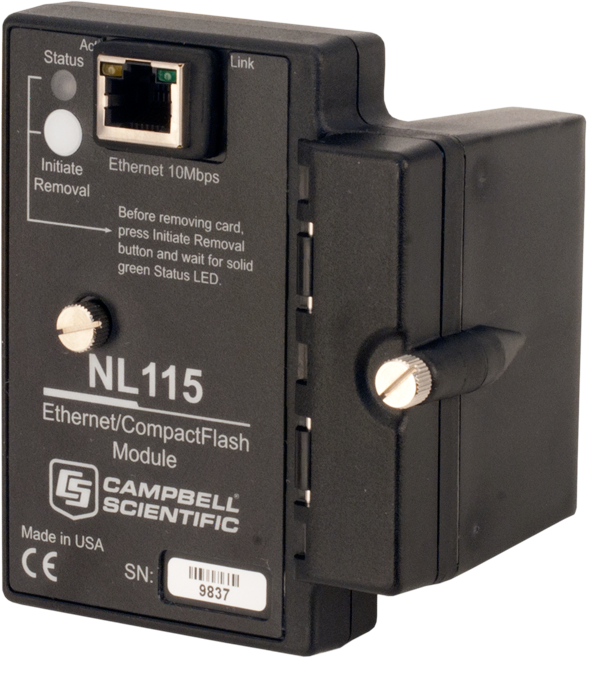This product is no longer available and has been replaced by: NL116. Some accessories, replacement parts, or services may still be available.

| Services Available |
|---|
Overview
Campbell Scientific’s NL115 enables 10baseT Ethernet communications and stores data on a removable CompactFlash® card. This small, rugged communication device connects to the 40-pin peripheral port on a CR1000 or CR3000 datalogger.
Read More
Benefits and Features
- Provides Ethernet communications and additional data storage for a CR1000 or CR3000 datalogger
- Ethernet connection allows for data logger communications over a local area network or the Internet via TCP/IP
- Removable CompactFlash cards can provide long-term data storage
- Small, light-weight CF cards fit in your pocket for easy transport between the data logger and PC
Images




Detailed Description
The NL115 allows the datalogger to communicate over a local network or a dedicated Internet connection via TCP/IP. A 10baseT Ethernet straight through cable is used when the cable is run from a hub to the NL115. A 10baseT Ethernet crossover cable is used if the cable is run directly from the computer to the NL115.
The NL115/CF card combination can be used to expand the datalogger's memory, transport data/programs from the field site(s) to the office, and upload power up functions. One Type I or Type II CompactFlash (CF) card fits into the NL115’s card slot.
Only industrial-grade CF cards should be used with our products. Although consumer-grade cards cost less than industrial-grade cards, the consumer-grade cards are more susceptible to failure resulting in both the loss of the card and its stored data. Industrial-grade cards also function over wider temperature ranges and have longer life spans than consumer-grade cards.
Data stored on the card can be retrieved either by removing the card and carrying it to a computer or through a communications link with the datalogger. The computer can read the CF card either with the computer’s PCMCIA slot and the CF1 adapter or the computer’s USB port and the 17752 Reader/Writer.
CardConvert is used to convert and save binary data from a CompactFlash® card. CardConvert is included in our PC200W, PC400, LoggerNet, and RTDAQ datalogger support software.
Compatibility
Please note: The following shows notable compatibility information. It is not a comprehensive list of all compatible products.
Dataloggers
| Product | Compatible | Note |
|---|---|---|
| CR1000 (retired) | ||
| CR200X (retired) | ||
| CR211X (retired) | ||
| CR216X (retired) | ||
| CR3000 (retired) | ||
| CR5000 (retired) | ||
| CR800 (retired) | ||
| CR850 (retired) | ||
| CR9000X (retired) |
Mounting Equipment
| Product | Compatible | Note |
|---|---|---|
| ENC10/12 | ||
| ENC10/12R | Attached to a CR1000 or CR3000 | |
| ENC12/14 | Attached to a CR1000 | |
| ENC14/16 | Attached to a CR1000 or CR3000 | |
| ENC16/18 | Attached to a CR1000 or CR3000 |
Additional Compatibility Information
CompactFlash (CF) Cards
Campbell Scientific offers and recommends several CF cards (see Ordering tab). These cards have passed Campbell Scientific's ESD testing and operate properly with our data loggers.
Only industrial-grade CF card should be used with our products. Although consumer-grade cards cost less than industrial-grade cards, the consumer-grade cards are more susceptible to failure resulting in both the loss of the card and its stored data. Industrial-grade cards also function over wider temperature ranges and have longer life spans than consumer-grade cards.
Software Requirements
The NL115 is set up using the Device Configuration utility (DevConfig). The NL115 requires LoggerNet 3.2 or later, PC400 1.3 or later, and DevConfig 1.5 or later.
Data Logger Considerations
The NL115 fastens onto the data logger's 40-pin peripheral port. This means that the NL115 is only compatible with the CR1000 and CR3000. It is NOT compatible with the CR800, CR850, CR200X, CR5000, or CR9000X dataloggers.
To read cards with more than 2 GB of storage, the data logger operating system must be OS 25 or later.
Specifications
| Power Requirements | 12 V supplied through the data logger’s peripheral port |
| Ethernet Speed | 10Base-T (10 Mbps), half-duplex |
| Typical Access Speed | 200 to 400 kbits s-1 |
| Memory Configuration | User selectable; ring (default) or fill-and-stop |
| CF Card Requirements | Industrial-grade |
| Data Logger Operating System (OS) | The CR1000 OS must be OS 9 or later. Both the CR1000 and CR3000 need OS 25 or later to read cards with more than 2 GB of storage. |
| Typical Current Drain |
|
| Dimensions |
|
| Weight | 154 g (5.4 oz) |
EMI and ESD Protection |
|
| European Standards | Meets requirements for a class A device under European Standards. |
| Application of Council Directive(s) | 89/336/EEC as amended by 89/336/EEC and 93/68/EEC |
| Standards to Which Conformity Is Declared | EN55022-1; 1995 and EN50082-1: 1992 |
Software Requirements |
|
| LoggerNet | Version 3.2 or later |
| PC400 | Version 1.3 or later |
| DevConfig | Version 1.5 or later |
Documents
Technical Papers
Frequently Asked Questions
Number of FAQs related to NL115: 22
Expand AllCollapse All
Case Studies
Tropical volcanic islands are biodiversity hotspots where the Critical Zone (CZ) remains poorly studied. In......read more
As concern over changing climate conditions in the world was growing in the late 1990s,......read more
Scientists and land-use managers have long recognized the importance of forest lands for their role......read more
Privacy Policy Update
We've updated our privacy policy. Learn More


